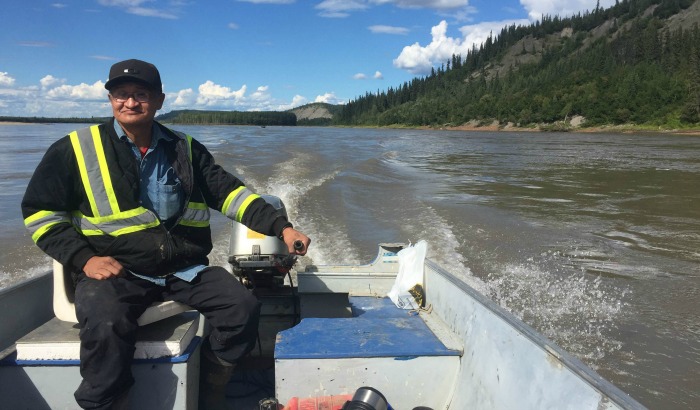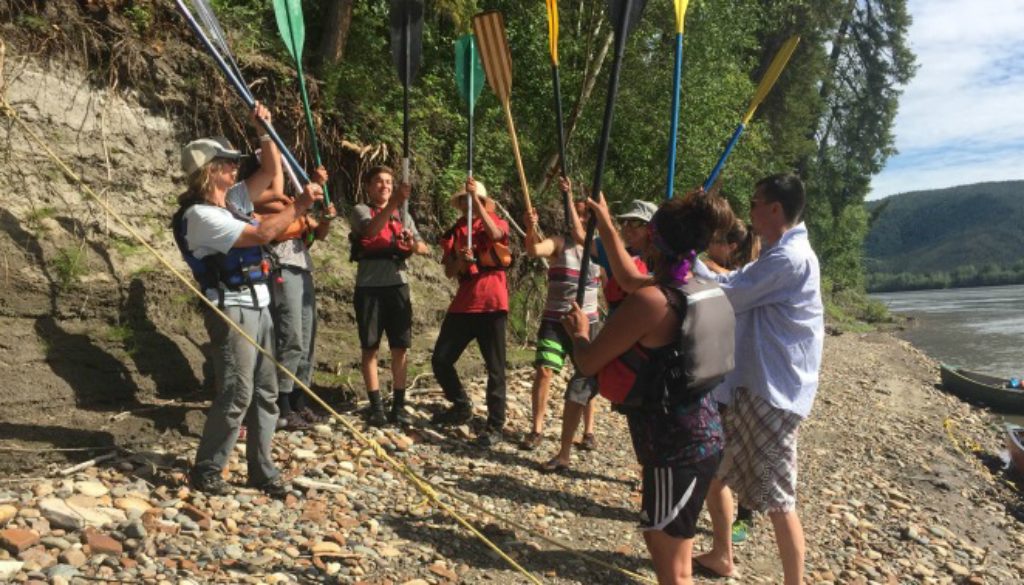Connected to the land: Chris Rider meets the Peel community of Fort McPherson
It’s difficult to express the impact that the recent journey of the Youth of the Peel had on me, given that it’s a trip that I wasn’t even on. But welcoming them off the water in July and talking with Gwich’in people in the Northwest Territories about the Peel left a strong impression on me.

Let me first give some background before I continue. Last year, CPAWS Yukon organized a canoe trip as a one-off project. The plan was to give a group of young people from First Nations with traditional territory in the Peel Watershed an opportunity to spend 18 days paddling approximately 500km on the Wind and Peel rivers. For some, it was the chance to connect with this part of their homeland for the first time, and for the whole group it meant becoming young ambassadors for the Peel Watershed.
What CPAWS hadn’t expected was that two of the youth – Bobbi Rose & Dana Tizya-Tram – would start Youth of the Peel as its own project and run similar trips every year. While there were challenges along the way, the community and the CPAWS team rallied behind them to make it possible.
On the morning of July 13th, I was standing on the dock in Mayo to see them start their journey on the river. This year there was a new group of youth, joined by founding members of Youth of the Peel, Bobbi Rose and Robert Neyando returning, this time as guides-in-training. Six new youth joined them, along with their two intrepid guides, Jill and Kate.
A little over two weeks later, I – along with a journalist from the Walrus writing a story about the youth – got on a plane to meet them at the other end of their journey. We flew up to Inuvik and then jumped in a taxi for the long drive down to Fort McPherson (Tetlit’ Zheh). We’d planned to camp that night, but hadn’t realized that the campground was 11km out of town. So, not having anywhere arranged to stay, we called a local bed & breakfast to get some rooms. In the first hint that this was going to be a special trip, the owner said to us: “Normally it’s $200 per room, but because you’re here to protect the Peel, I’ll give it to you half price”.
The next morning, we met with Clarence Alexie and Robert James, who would be driving the boats. The plan was to travel upriver to meet the youth at the confluence of the Caribou and Peel Rivers. From there we’d pick them up and pull the canoes the rest of the way back to Fort McPherson.

The journey along the Peel River took about 5 or 6 hours each way and brought us through some spectacular scenery. As we travelled along the river, Clarence and the youth from Fort McPherson and Tsiigehtchic (another nearby Gwich’in community) would remark, “over that mountain is where we go to hunt caribou,” or they would recount a story about a specific place from hundreds of years ago. Their connection with the land is extraordinary.
On the way back, we stopped overnight at Robert Alexie Sr.’s cabin. Robert Alexie Sr. is Bobbi Rose’s grandfather and Clarence Alexie’s father. The cabin was on a site that has been used by their family for generations. The trip brought substance to what I knew already in my mind: This is the land where their ancestors are buried and have lived for thousands of years. This is the land that Yukon Government wants to mine.
Once we returned to Fort McPherson, we joined up with Joanna Jack (CPAWS Yukon’s Conservation Programs & Outreach Coordinator) and Cathie Archbould, a photographer we’d brought up to work on a project in Fort McPherson. Together we drove down the Dempster to Midway Music Festival, an annual gathering organized by the Tetlit Gwich’in. It’s a drug and alcohol free celebration attended by people from Fort McPherson and the surrounding communities. It’s a truly multigenerational event, with everyone from small children to Elders in attendance. Over the years, families have set up permanent cabins within the festival grounds, which they return to every year.
During our time at the festival, the generosity of the families was humbling, and I don’t think I’ve ever felt so welcomed anywhere in my life. I’ve also never eaten so well, because everywhere we walked, someone would offer us food or a cup of tea or coffee. I tried many different caribou dishes, roast beaver and even a little bit of muktuk brought in from delta communities downstream.
We also heard stories about how connected the community remains to the Peel Watershed, which for many people in Fort McPherson is not just a home, but also a source of food and income. People hunt, fish and trap, and then sell what they don’t need, like extra dry-fish or fur or hide to make moccasins. More than one person asked us: “If they mine and the waters and the land become polluted, how will I live?” Hearing these stories, I wondered that too.

Before I had this experience, I knew that the work we are doing to save the Peel Watershed was critical. But my time in Fort McPherson and on the Peel River changed something within me. It’s no longer just an intellectual feeling; in my heart, I now understand what this whole legal fight means for the land, for the animals and for the people who have depended on the Peel for millennia.
When we asked Alice Vittrekwa, a Tetlit Gwich’in Elder, what she would tell the people who are deciding the Peel’s fate, her response was; “I’d tell them to come up here, to see the land for themselves and to come and talk to us and hear our stories. Then they can decide.”
I can’t help but agree.
-Chris Rider, CPAWS Yukon Executive Director

